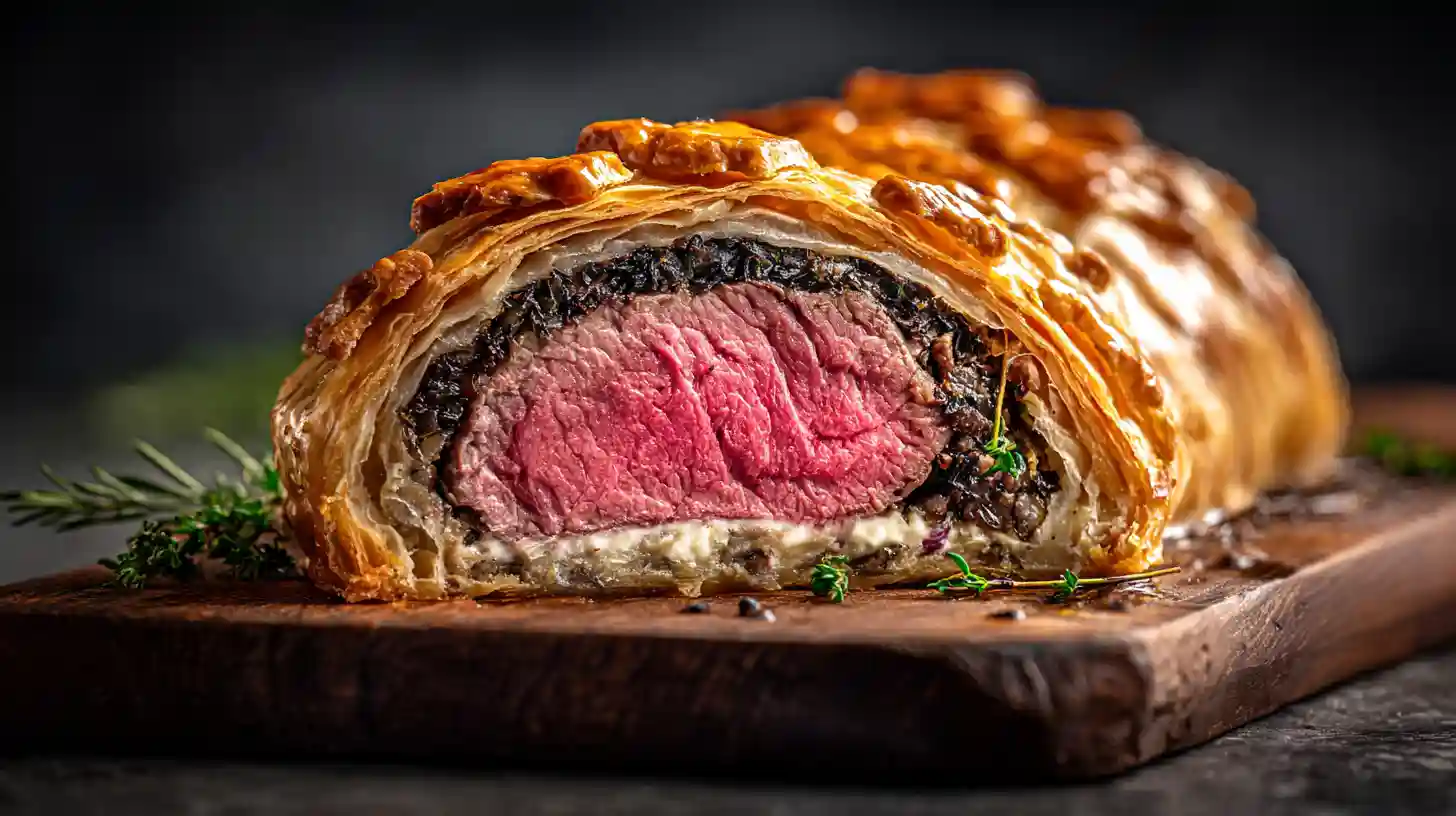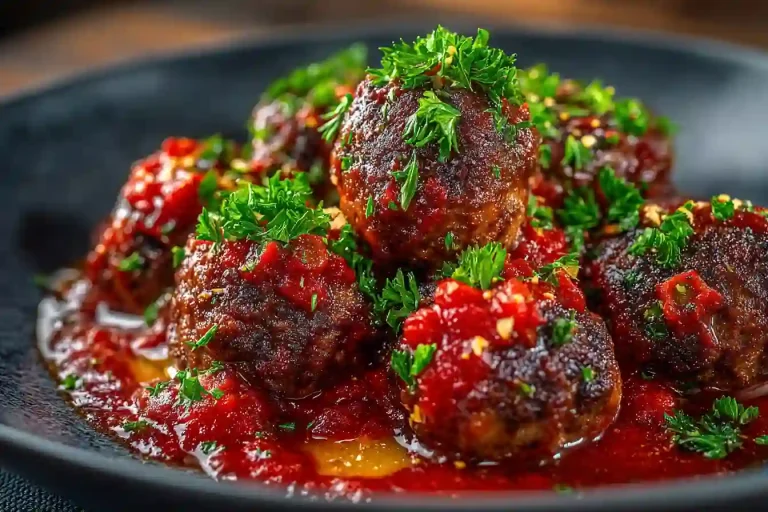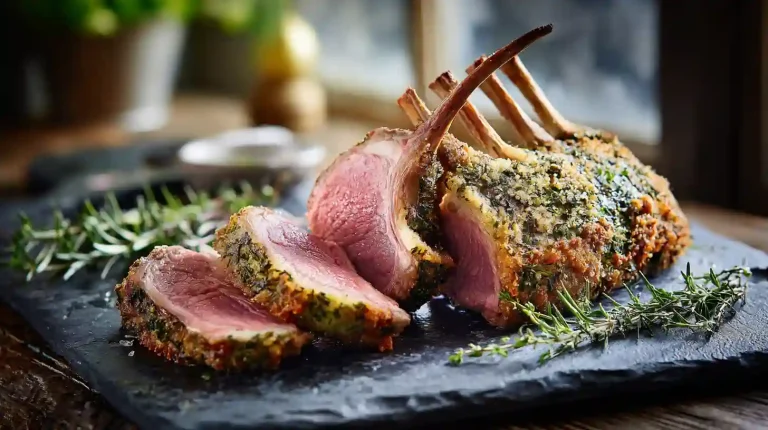Gordon Ramsay Beef Wellington: The #1 Secret to No Soggy Bottom
There is no culinary failure more spectacular, more expensive, or more heartbreaking than a soggy bottom on a Gordon Ramsay Beef Wellington. I know, because my first attempt was a catastrophe. I followed a recipe I found online, pulled my masterpiece from the oven, and watched in horror as the knife revealed a pale, damp, and doughy disgrace under a perfectly cooked fillet. I had created a culinary tragedy.
I’m Jack Barrett. I don’t accept failure. I went back to the source—every TV show, every masterclass—and I realized the truth: a perfect Gordon Ramsay Beef Wellington is not a recipe; it’s an engineering project. Every single step is a deliberate, calculated defense against the enemy: moisture. I’ve decoded this defensive system, from the bone-dry duxelles to the non-negotiable crepe barrier. This isn’t just another recipe. This is the blueprint that makes the ultimate showstopper foolproof.
The Method: The Soggy Bottom Defense System
An authentic Gordon Ramsay Beef Wellington is a fortress of layers, each with a specific job. Understanding the why behind each layer is the key to a flawless result. This system is designed to deliver two things: perfectly medium-rare beef and a shatteringly crisp pastry crust.
- The Sear (The Flavor Armor): The first step is to get a screaming hot pan and sear the seasoned beef fillet on all sides. This is not about “sealing in juices.” This is about creating flavor. That deep, brown crust from the Maillard reaction is the first and most fundamental layer of taste. “No color, no flavor,” as Ramsay says. This crust also acts as the first barrier in our defensive system for the Gordon Ramsay Beef Wellington.
- The Duxelles (The Moisture Enemy #1): The mushroom mixture is delicious, but it’s also the primary source of steam that will ruin your pastry. You must cook the finely chopped mushrooms in a dry pan until they are bone-dry. I mean completely, utterly dry. They will go from a wet slurry to a dark, crumbly paste. If there is any moisture left, you are setting your Gordon Ramsay Beef Wellington up for failure.
- The Prosciutto & Crepe Barrier (The Ultimate Defense): This is the genius of the Ramsay method. First, overlapping slices of prosciutto create a salty, savory wrapping that seasons the beef. But the real secret, the non-negotiable step that most online recipes get wrong, is the crepe. A thin, unsweetened crepe is laid over the prosciutto and duxelles. This crepe is your sacrificial layer. It’s a sponge designed to absorb any moisture that escapes the duxelles, ensuring the puff pastry stays perfectly dry and crisp. A perfect Gordon Ramsay Beef Wellington is built on this barrier.
- The Chilling Stages (The Thermodynamic Law): You will chill the Wellington multiple times: after searing, after wrapping in prosciutto, and after wrapping in pastry. This is critical. A cold, firm Wellington going into a very hot oven ensures the pastry starts cooking instantly, getting that “puff” before the heat has time to penetrate and overcook the beef. This is a non-negotiable part of the engineering for every Gordon Ramsay Beef Wellington.
Mistake Watchouts: I Failed So You Don’t Have To
My first Gordon Ramsay Beef Wellington was for a New Year’s Eve dinner. It looked magnificent coming out of the oven. I felt like a culinary hero, until I made the first slice. The bottom pastry was a pale, damp, and doughy mess. It was an expensive, embarrassing failure that taught me more than any recipe ever could. Here’s what I did wrong.
- The Mistake: A Wet Duxelles. I was impatient. The mushrooms looked dry enough, but they weren’t. That hidden moisture turned to steam in the oven and attacked the pastry from the inside out, turning the bottom of my Gordon Ramsay Beef Wellington into a soggy sponge.
- The Fix: Be obsessive. Cook the duxelles until it’s a dark, crumbly paste and the pan is completely dry. When you think it’s done, cook it for another two minutes.
- The Mistake: I Thought the Crepe was Optional. I saw it in a video and thought it was overkill. This was my single greatest error. That crepe is not a suggestion; it’s the most important part of the Soggy Bottom Defense System. It is the final firewall between the filling and the pastry.
- The Fix: Make the crepe. It takes five minutes. Do not skip this step. A perfect Gordon Ramsay Beef Wellington is impossible without it.
The Recipe: Gordon Ramsay’s Perfect Beef Wellington
Gordon Ramsay’s Perfect Beef Wellington
Ingredients
Equipment
Method
- Sear & Chill Beef: Season fillet generously. Sear in a hot, oiled pan on all sides until browned (1-2 mins per side). Cool slightly, then brush all over with mustard. Chill for 30 mins.
- Make Duxelles: Pulse mushrooms in a food processor to a coarse paste. Cook in a hot, DRY pan for 10-15 mins until all moisture evaporates and it resembles a dark paste. Season and cool completely.
- Make Crepe: Whisk crepe ingredients (flour, egg, milk) until smooth. Cook one large, thin crepe in a lightly oiled pan. Set aside.
- Assemble: On a large sheet of plastic wrap, lay out the prosciutto slices in a rectangle. Spread the dry duxelles over it, then lay the crepe on top. Place the chilled beef at one end and use the plastic wrap to roll it all up into a tight cylinder. Twist the ends and chill for 20 mins.
- Wrap in Pastry: Roll out the puff pastry. Unwrap the beef log and place it on the pastry. Brush edges with egg wash and wrap tightly, trimming excess. Place seam-side down on a parchment-lined baking sheet. Chill for another 20 mins.
- Bake: Preheat oven to 400°F (200°C). Brush the Wellington with egg wash, score the top with the back of a knife, and sprinkle with coarse sea salt. Bake for 18-22 minutes until pastry is golden. Internal temp should be 125°F (52°C) for medium-rare.
- REST: Let the Wellington rest for 10-15 minutes before slicing with a serrated knife. This is a non-negotiable step.
Nutrition
Notes
Love this recipe?
Give us 5 stars and comment!The Execution: Step-by-Step
- Sear the Fillet: Season the beef fillet generously with salt and pepper. Sear in a very hot, oiled pan on all sides until deeply browned (1-2 mins per side). Remove and let cool, then brush all over with English mustard. Chill for 30 minutes.
- Make the Duxelles: Finely chop mushrooms in a food processor. Cook in a dry, hot pan over medium-high heat, stirring frequently, for 10-15 minutes until all moisture has evaporated. Season and cool completely.
- Assemble the Wrap: Lay out a large sheet of plastic wrap. Arrange prosciutto slices in an overlapping rectangle. Spread the cooled duxelles evenly over the prosciutto. Place a thin, unsweetened crepe on top.
- Wrap the Beef: Place the chilled fillet at one end. Using the plastic wrap, tightly roll the beef up, enclosing it completely. Twist the ends of the plastic wrap to form a tight cylinder. Chill for at least 20 minutes.
- Wrap in Pastry: Roll out a sheet of puff pastry. Unwrap the beef log and place it on the pastry. Brush the edges with egg wash and tightly wrap the beef, trimming any excess. Place seam-side down on a parchment-lined baking sheet.
- Chill and Score: Chill the entire Wellington for a final 20 minutes. Brush all over with egg wash. Use the back of a knife to gently score a decorative pattern. Sprinkle with coarse sea salt.
- Bake: Bake at 400°F (200°C) for 18-22 minutes, or until the pastry is golden brown and crisp. A thermometer inserted into the center should read 125°F (52°C) for medium-rare.
- Rest: This is critical. Let the Wellington rest for a full 10-15 minutes before slicing.
Sanctioned Riffs (Variations That Respect the Method)
The defensive system of a Gordon Ramsay Beef Wellington is sacred, but you can make minor flavor adjustments. You can add a thin layer of pâté (like pâté de foie gras) over the crepe for extra richness. You can also add finely chopped fresh thyme or other herbs to the duxelles mixture. The key is that any addition must not compromise the dryness of the filling or the integrity of the pastry wrap.
Plating and Execution
Let the rested Wellington be the star. Place it on a large cutting board at the table. Use a long, sharp serrated knife to slice it into thick, 1.5-inch portions. The first cut reveals the masterpiece: the perfect pink center, the dark ring of duxelles, and the golden, flaky pastry. Serve with a simple red wine reduction sauce and creamy mashed potatoes. Nothing should overpower the magnificent Gordon Ramsay Beef Wellington.

Recipe FAQs
Did Gordon Ramsay invent Beef Wellington?
No, Gordon Ramsay did not invent the Beef Wellington. The dish is believed to be named after Arthur Wellesley, the first Duke of Wellington, in the 19th century. However, Ramsay has perfected and popularized the dish for the modern era. His meticulous method for creating a perfect Gordon Ramsay Beef Wellington has become the gold standard.
How much does a Beef Wellington cost at a Gordon Ramsay restaurant?
The price varies by location, but a Gordon Ramsay Beef Wellington typically costs between $70 and $100 per person at his restaurants. This makes learning to master the dish at home not only a rewarding culinary achievement but also a significant value.
Why did my pastry go soggy on the bottom?
A soggy bottom on your Gordon Ramsay Beef Wellington is almost always caused by one of two things: your mushroom duxelles was not cooked until completely dry, or you skipped the essential crepe barrier. The crepe is the final line of defense against moisture and is non-negotiable.
The Result / Conclusion
When you slice into a perfect Gordon Ramsay Beef Wellington, the sound is the first reward: a distinct crack as the knife breaks through the crisp puff pastry. Then you see it—the flawless layers. The deep pink of the perfectly medium-rare beef, the dark, earthy ring of the duxelles, and the golden, flaky pastry shell with a perfectly crisp bottom. You didn’t just cook a piece of meat. You executed a complex piece of culinary engineering. You conquered the showstopper.
Your Turn. Get to Work.
You’ve mastered the pinnacle of showstopper dishes. Now apply that same precision to other legendary red meat preparations. Continue your education with the definitive guide to Gordon Ramsay’s Beef & Lamb Recipes.









